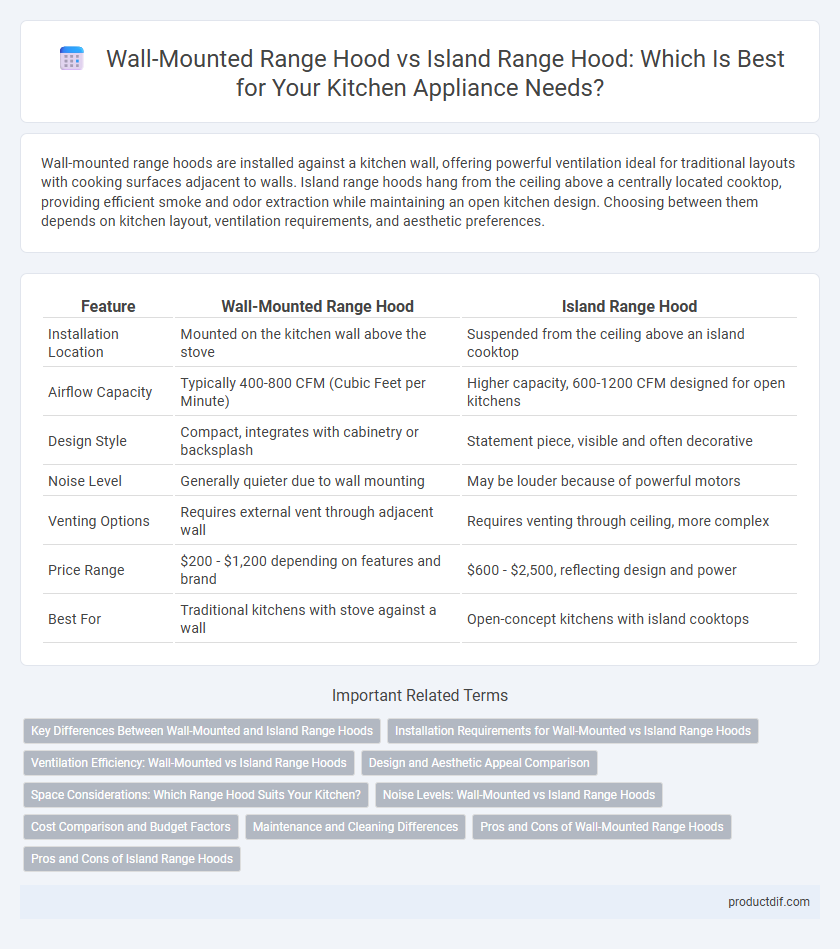Wall-mounted range hoods are installed against a kitchen wall, offering powerful ventilation ideal for traditional layouts with cooking surfaces adjacent to walls. Island range hoods hang from the ceiling above a centrally located cooktop, providing efficient smoke and odor extraction while maintaining an open kitchen design. Choosing between them depends on kitchen layout, ventilation requirements, and aesthetic preferences.
Table of Comparison
| Feature | Wall-Mounted Range Hood | Island Range Hood |
|---|---|---|
| Installation Location | Mounted on the kitchen wall above the stove | Suspended from the ceiling above an island cooktop |
| Airflow Capacity | Typically 400-800 CFM (Cubic Feet per Minute) | Higher capacity, 600-1200 CFM designed for open kitchens |
| Design Style | Compact, integrates with cabinetry or backsplash | Statement piece, visible and often decorative |
| Noise Level | Generally quieter due to wall mounting | May be louder because of powerful motors |
| Venting Options | Requires external vent through adjacent wall | Requires venting through ceiling, more complex |
| Price Range | $200 - $1,200 depending on features and brand | $600 - $2,500, reflecting design and power |
| Best For | Traditional kitchens with stove against a wall | Open-concept kitchens with island cooktops |
Key Differences Between Wall-Mounted and Island Range Hoods
Wall-mounted range hoods are installed against a kitchen wall and typically offer stronger ventilation performance due to direct ducting, making them ideal for compact kitchen layouts. Island range hoods are suspended from the ceiling over a kitchen island, requiring ceiling ductwork and often featuring a more aesthetic design to complement open kitchens. The primary differences include installation location, ventilation efficiency, and design impact on kitchen layout.
Installation Requirements for Wall-Mounted vs Island Range Hoods
Wall-mounted range hoods require secure attachment to a wall structure, necessitating precise alignment with existing cabinetry and ventilation ducts, while island range hoods demand ceiling support and often more complex ductwork due to their central location. Proper clearance and electrical wiring must comply with local building codes for both, but island hoods typically require reinforced ceiling framing to support heavier models. Installation of wall-mounted units is generally simpler and less invasive compared to island hoods, which need careful consideration of ceiling height and open space integration.
Ventilation Efficiency: Wall-Mounted vs Island Range Hoods
Wall-mounted range hoods generally offer superior ventilation efficiency due to their proximity to the cooking surface and walls, which allows for better capture of smoke and odors. Island range hoods require more powerful fans and larger ductwork to achieve similar ventilation performance because they are suspended away from walls and open on all sides. Proper installation and duct design are crucial for maximizing airflow and minimizing noise in both types of range hoods.
Design and Aesthetic Appeal Comparison
Wall-mounted range hoods offer a sleek and integrated look that complements kitchen cabinetry, enhancing vertical space with minimalist design lines. Island range hoods serve as a dramatic focal point, featuring bold designs and finishes that create visual interest in open kitchen layouts. Both styles prioritize functionality but differ in aesthetic impact: wall-mounted hoods blend seamlessly with the backdrop, while island hoods command attention as centerpiece elements.
Space Considerations: Which Range Hood Suits Your Kitchen?
Wall-mounted range hoods are ideal for kitchens with limited space as they attach directly to the wall above the stove, maximizing vertical space and providing efficient ventilation without crowding the cooking area. Island range hoods require ceiling mounting and ample overhead clearance, making them better suited for open-concept kitchens with a central cooking island where larger, more powerful ventilation is needed. Assessing available space and kitchen layout is crucial in choosing between these range hood types to ensure optimal airflow and design harmony.
Noise Levels: Wall-Mounted vs Island Range Hoods
Wall-mounted range hoods typically operate with lower noise levels due to their enclosed mounting structure, reducing sound resonance compared to island range hoods. Island range hoods require more powerful fans to ventilate open kitchen spaces, often resulting in higher decibel output. Selecting a model with advanced sound insulation technology can significantly improve noise performance in either hood type.
Cost Comparison and Budget Factors
Wall-mounted range hoods generally cost between $300 and $1,200, offering a more budget-friendly option compared to island range hoods, which can range from $500 to $2,000 due to their complex installation requirements. Installation expenses for island range hoods tend to be higher, often doubling the overall cost because of ceiling mounting and additional ductwork. When budgeting, homeowners should consider not only the hood price but also electrical work, ducting complexity, and kitchen layout to determine the most cost-effective solution.
Maintenance and Cleaning Differences
Wall-mounted range hoods typically have easier access for cleaning filters and surfaces, reducing the buildup of grease and dust due to their fixed position against a wall. Island range hoods, suspended from the ceiling, require more effort to reach for routine maintenance and often need professional help for filter replacement and deep cleaning. Proper maintenance frequency varies, but experts recommend monthly cleaning to ensure optimal performance and extend the lifespan of both types of range hoods.
Pros and Cons of Wall-Mounted Range Hoods
Wall-mounted range hoods offer efficient ventilation and a sleek design that complements kitchen walls, making them ideal for cooking areas adjacent to cabinetry. They provide strong extraction power and ease of installation compared to island range hoods, but their placement limits flexibility and may not suit open-concept kitchens with central cooktops. Noise levels and maintenance accessibility can vary depending on the motor type and duct configuration, impacting long-term usability.
Pros and Cons of Island Range Hoods
Island range hoods offer superior ventilation for cooktops located on kitchen islands, effectively removing smoke, odors, and grease from multiple directions. However, they require ceiling mounting and may involve complex installation, increasing costs and limiting placement flexibility. Their open design enhances kitchen aesthetics, but noise levels can be higher compared to wall-mounted models.
Wall-Mounted Range Hood vs Island Range Hood Infographic

 productdif.com
productdif.com